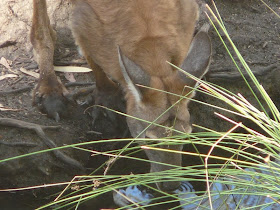As I write, it's 36 degrees Celsius here in Canberra (and close to that here in my study!); the coming days are predicted to be 39, 39, 38 and 37. In Adelaide, my birth town on the south coast of Australia, it's currently 43, with predicted maxima of over 40 for the next three days. This is normally the hot time of year for southern Australia in particular, but we are grimly aware (as are our North American friends at present) that climatic extremes are the norm of the future, given our unwillingness to do anything about them.
The radio has been reminding me to keep up my water intake, and the bird bath outside is hosting a stream of heavy drinkers. Their styles vary however. Pigeons can suck up water, enabling them to drink quickly and leave again - waterholes are magnets to predators and thus very dangerous places to hang about. (And no, none of the following pics were taken at our bird bath!)
 |
| Bar-shouldered Doves Geopelia humeralis, Idalia National Park, central Queensland. |
 |
| Diamond Doves Geopelia cuneata, West MacDonnell Ranges, Northern Territory. |
Most however have to scoop up a beakful of water and tip it back.
 |
| White-winged Choughs Corcorax melanorhamphos, Canberra. |
 |
| Emu Dromaius novaehollandiae, near Esperance, Western Australia. |
 |
| Zebra Finches Taeniopygia guttata, Serpentine Gorge, West MacDonnell Ranges, Northern Territory. Like other desert seed-eaters (including pigeons and parrots) Zebbies must drink daily. |
More dramatically, some birds will swoop onto water to scoop it up in flight, or by skimming the water.
Predatory and fruit-eating birds can get most of their needs from their food, and rarely need to drink.
Mammals too have different approaches to drinking. Carnivores, which are not generally threatened when drinking, tend to lie down and lap water in a leisurely fashion, using the tongue to scoop it up.
 |
| Sumatran Tiger Panthera tigris sumatrae, Adelaide Zoo. |
Its prey however must be more efficient than that, and many antelope and horses for instance form a tube with their lips and 'suck' by using the tongue as a pump. (The following photos have been scanned from old slides, hence the ordinary quality.)
 |
| Black-faced Impala Aepyceros melampus petersi, Etosha NP, Namibia. |
 |
| Gemsbok Oryx gazella, Etosha NP, Namibia. This desert antelope rarely needs to drink. |
 |
| male Kudu Tragelaphus strepsiceros, Etosha NP, Namibia. |
 |
| Springbok Antidorcas marsupialis, Etosha NP, Namibia. It is quite likely that fully entering the water makes it safer with regard to lions and other predators - though not crocodiles! |
 | |
| Plains Zebras Equus quagga, Etosha NP, Namibia. |
Giraffe drink similarly, but must go to much more trouble to get down, and are particularly vulnerable once in the drinking position.
 |
| Giraffe Giraffa camelopardalis, Etosha NP, Namibia. |
And elephants of course have a particular advantage.
 |
| African Bush Elephant Loxodonta africana drinking, Okavango Delta, Botswana. |
Closer to (my) home it seems that kangaroos have evolved the same drinking method, though I can't be sure that they don't discretely lap.
 |
| Euro Macropus robustus, Idalia NP, central Queensland. |
And finally for vertebrates today, this big goanna just walked in and gulped!
 |
| Lace Monitor Varanus varius, Pilliga forest, New South Wales. |
Butterflies have a proboscis primarily for absorbing nectar by osmosis, but it works equally well for water.
 |
| Butterflies taking water from Amazonian riverbank mud; Manu River, Peru (above) and Yasuni NP, Ecuador (below). The proboscis of the animal below is clearly visible. |
All this blogging has made me thirsty, and the temperature here has crept up to 37, so I might say 'cheers' for now. But I'll be back later in the week, when it will be at least as hot, to look at animals bathing.
BACK ON FRIDAY



You might like the recent photos on Le Jardin de Lucie. She's been doing a series of posts on the pigeons and doves she photographed on her 2012 Australian trip.
ReplyDeleteYes, her pics are excellent - thanks for the heads-up Susan.
ReplyDeleteDo you have any comment about Sandgrouse "loading up" their feathers with water to transport it around? This may be another legend!
ReplyDeleteThe tale is from tropical Africa, so highly appropriate to what is currently on offer as weather around here!!
Martin
No, that one's absolutely true Martin, at least in as far as males carry water absorbed in their breast feathers to chicks. However they don't just carry spare with them, just in case...
ReplyDeleteFriends tell me that some birds also make use of swimming pools, but I'm not sure whether for drinking or washing.
ReplyDelete